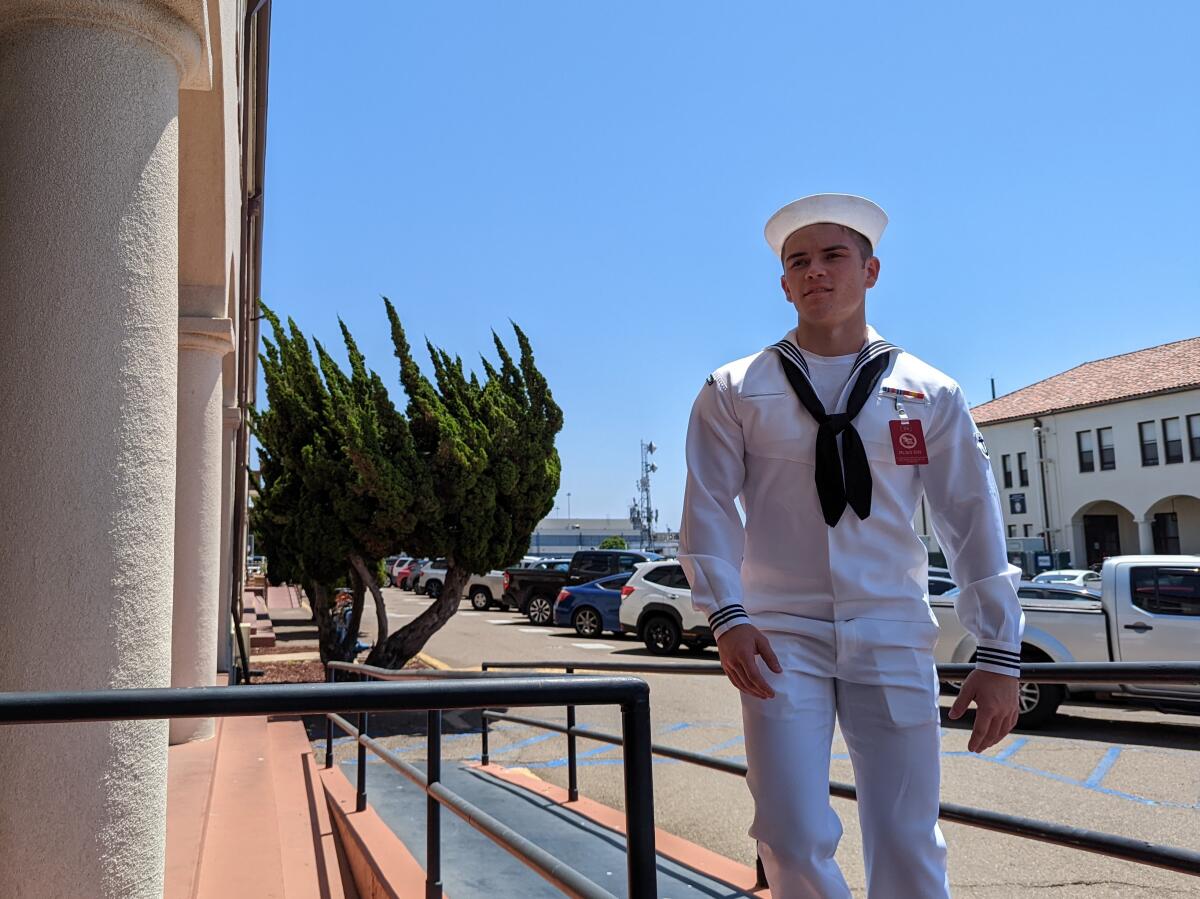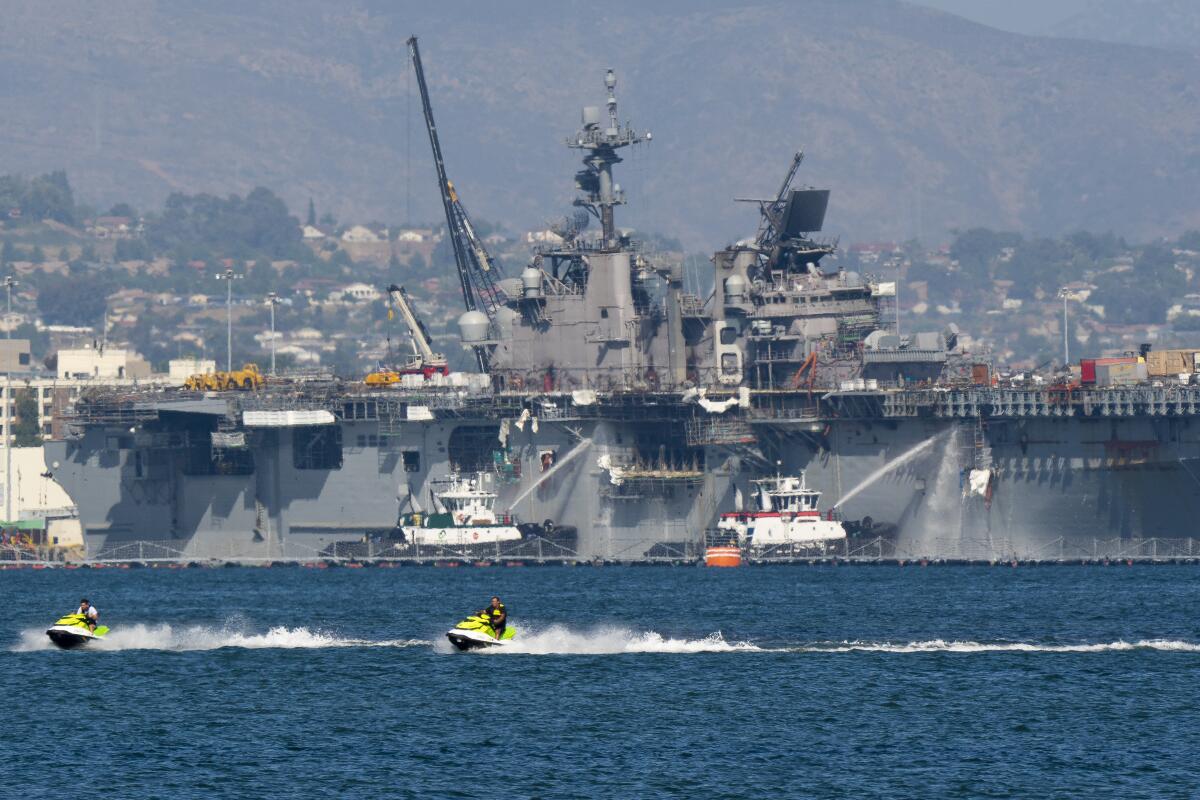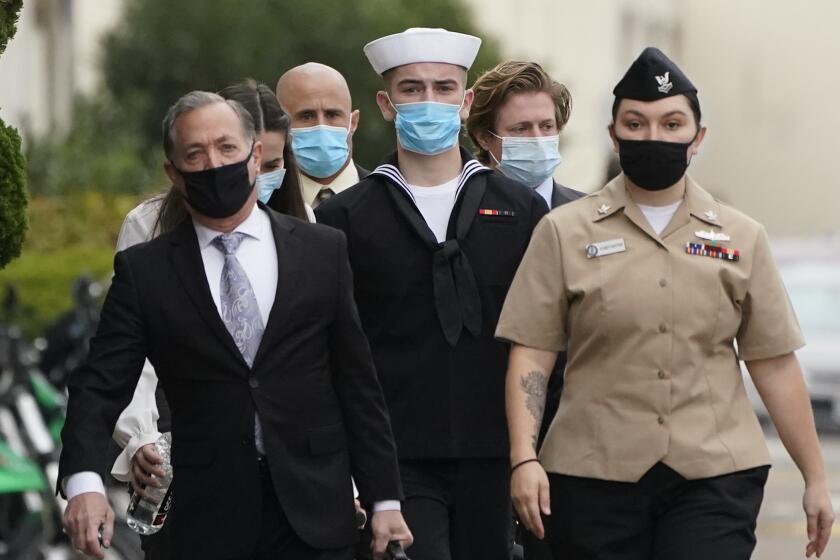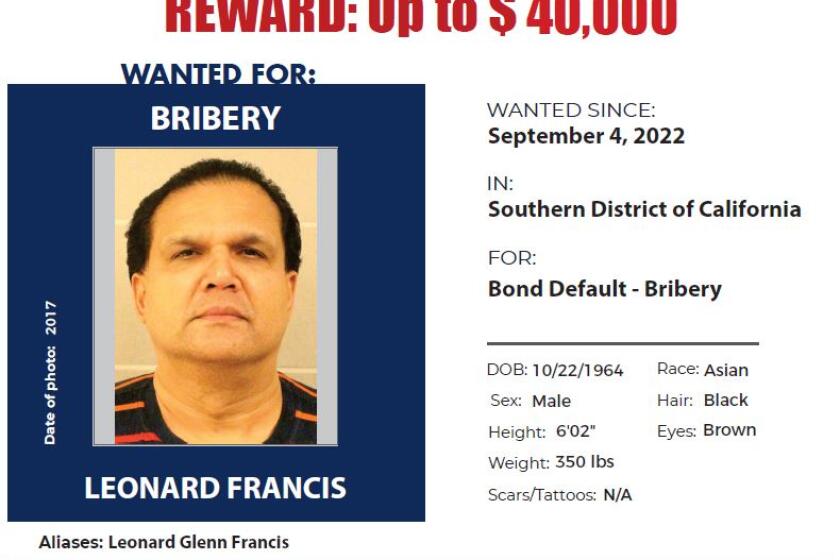An ‘act of defiance gone wrong’: Navy prosecutors say sailor hated life on San Diego warship, set fire

- Share via
SAN DIEGO — A 19-year-old San Diego sailor was so unhappy with his life as a deck seaman after failing to become a Navy SEAL that, in the summer of 2020, he snuck into a vehicle storage area on the amphibious assault ship Bonhomme Richard and ignited a spark, according to Navy prosecutors. That spark turned into a blaze that, over the next four days, burned and destroyed the $1.2-billion dollar warship.
That’s the story Navy Cmdr. Leah O’Brien told a judge during opening statements in the court-martial of Seaman Recruit Ryan Mays that kicked off this week. Over the past two days, prosecutors have begun to lay the foundation of their case for arson — a charge that could send the sailor to prison for life if found guilty.
Mays, now 21, is charged with aggravated arson and the willful hazarding of a vessel. He denies the charges and officially entered a plea of not guilty Monday morning at the start of the proceedings at Naval Base San Diego. The sailor waived his right to a trial by military jury. The case is being heard by the military judge, Navy Capt. Derek Butler, who will be tasked with rendering a verdict and sentencing Mays should he be convicted.
O’Brien said Mays found himself working essentially as a janitor on the Bonhomme Richard, a duty far beneath what the sailor envisioned for himself when he enlisted to become a SEAL. That did not happen, O’Brien said. Mays “rung the bell” — or quit — the Navy’s Basic Underwater Demolition/SEAL school in Coronado on his second day.
The preliminary hearing opens in the military case against Seaman Ryan Mays, accused of setting a fire that devastated the USS Bonhomme Richard in san Diego.
When sailors fail to complete BUD/S they are sent to the fleet Navy as so-called “undesignated” sailors — meaning they do not receive specialty job training or follow-on schools before reporting to their first duty stations.
It “was not the glory he envisioned,” O’Brien said of Mays’ job as an undesignated seaman on a Navy warship. “He absolutely hated his job.”
The Bonhomme Richard was nearing the end of a prolonged maintenance period during the summer of 2020, and its crew was not living aboard. When Mays was informed he’d be moving back onto the ship that Monday, July 13, he texted his division officer the ship was “hazardous” because “contractors could catch his rack on fire,” O’Brien said.
One sailor on watch that morning told Navy investigators he saw Mays — in a mask — walk into the ship’s lower vehicle storage area carrying a bucket minutes before he saw smoke coming up the vehicle ramp.
The fire Mays ignited on board was a “mischievous act of defiance gone wrong,” O’Brien told the court.

Navy Lt. Tayler Haggerty, one of Mays’ three active-duty military judge advocates, said Navy and federal investigators were quick to blame the fire on arson and hasty to zero in on Mays as their prime suspect. Haggerty said “cognitive bias” led law enforcement astray when they eliminated another Bonhomme Richard sailor as a suspect — even though he’d searched heat scales on Google less than an hour before the fire began.
Haggerty said Mays was determined to get back into an elite program, be it the SEALS or Explosive Ordinance Disposal, and had not given up on the Navy.
“He still had hope,” Haggerty told the judge.
Eight former Bonhomme Richard sailors on the ship that morning testified Monday, including three who were the first to venture into the so-called “lower V” area and see the fire’s origin.
Three of the eight testified that the sailor who allegedly saw Mays head down into the area just minutes before never told them someone might be down there.
Special Agent Matthew Beals, a certified fire investigator with the U.S. Bureau of Alcohol, Tobacco, Firearms and Explosives, testified Tuesday that there was no doubt that the fire was deliberately set. Beals, an investigator based in San Diego, led the team that pored over the vessel in the days and weeks after the blaze.
The investigation concluded that the fire was caused by a person who applied an open flame to a triple-thick cardboard box, known as a tri-wall, in the lower V using a liquid accelerant, such as lighter fluid or paint thinner, Beals said.
The statement in 2020 by a doctor focuses attention on a medical furlough Leonard Francis, now a fugitive, lived under since 2018.
Lt. Cmdr. Jordi Torres, Mays’ lead defense attorney, questioned Beals for more than three hours in a somewhat combative cross-examination. Torres questioned Beals’ conclusion of arson despite the discovery of lithium-ion batteries — which Beals conceded have been known to start fires — among the debris near the burned boxes in the lower V.
Beals said that after the battery issue was raised by the defense at a hearing in December, he took the batteries to a Maryland fire research lab to test whether their failure could have set a tri-wall on fire.
Beals said he approaches his work scientifically and is willing to test possibilities. However, he came away from the battery tests even more convinced they were not the fire’s cause.
“It remains incendiary,” he told Torres of his conclusion, meaning the fire was intentionally set.
Capt. Jay Jones, the Navy’s lead prosecutor, told the judge Tuesday he expects the government’s key witness — Petty Officer Kenji Velasco — will take the stand Wednesday afternoon.
Velasco, who was on watch near the upper vehicle storage area the morning of the fire, testified in a previous hearing that he saw Mays walk down the ramp from the upper V to the lower V just minutes before he saw smoke drifting up the ramp.
Prosecutors said they expect to rest their case Friday. The trial is scheduled through Sept. 29.
More to Read
Sign up for Essential California
The most important California stories and recommendations in your inbox every morning.
You may occasionally receive promotional content from the Los Angeles Times.











